PONTIAC BONNEVILLE 1993 Owners Manual
Manufacturer: PONTIAC, Model Year: 1993, Model line: BONNEVILLE, Model: PONTIAC BONNEVILLE 1993Pages: 322, PDF Size: 16.31 MB
Page 161 of 322
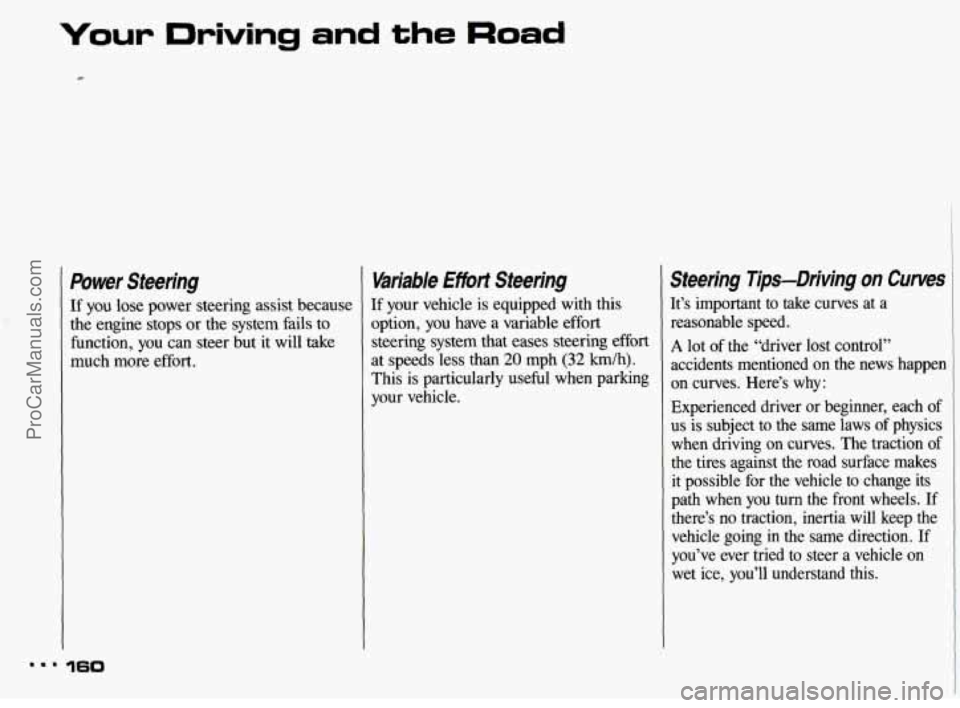
Your Driving and the Road
Power Steering
If you lose power steering assist because
the engine stops or the system fails to
function, you can steer but it will take
much more
effort.
Variable Effort Steering
If your vehicle is equipped with this
option, you have a variable effort
steering system that eases steering effort
at speeds less than
20 mph (32 Wh).
This is particularly useful when parking
your vehicle.
Steering Tips-Driving on Curves
It’s important to take curves at a reasonable speed.
A lot of the “driver lost control”
accidents mentioned on the news happen on curves. Here’s why:
Experienced driver or beginner, each of
us is subject to the same laws of physics
when driving on curves. The traction
of
the tires against the road surface makes
it possible for the vehicle to change
its
path when you turn the front wheels. If
there’s no traction, inertia will keep the vehicle going in the same direction.
If
you’ve ever tried to steer a vehicle on
wet ice, you’ll understand this.
mmm 160
ProCarManuals.com
Page 162 of 322
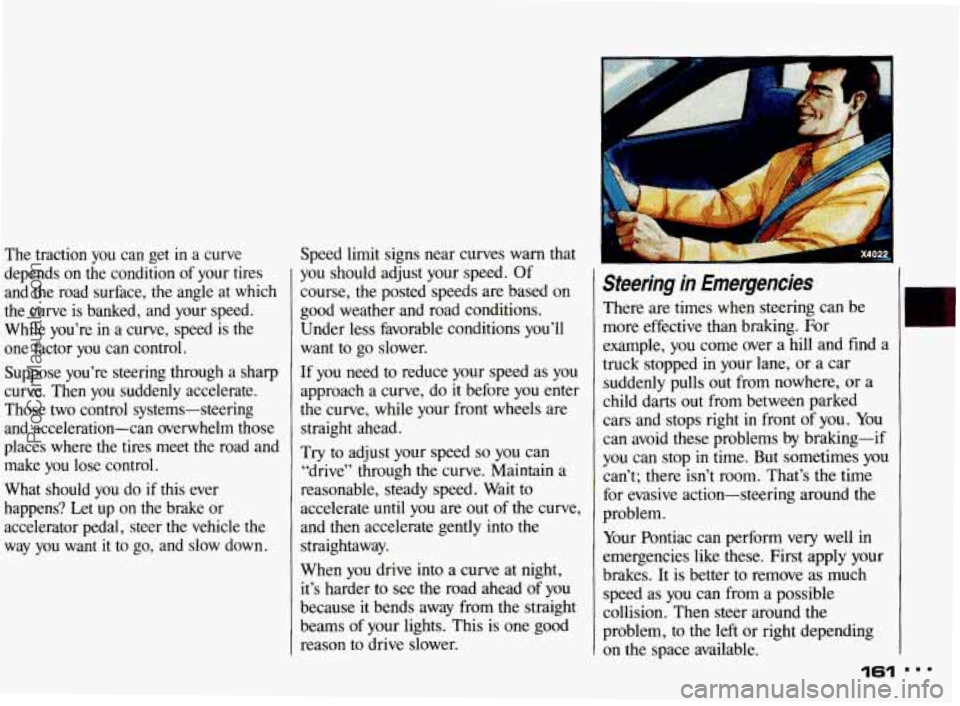
The traction you can get in a curve
depends on the condition of your tires
and the road surface,
the angle at which
the curve is banked, and your speed.
While you’re
in a curve, speed is the
one factor you can control.
Suppose you’re steering through a sharp
curve. Then you suddenly accelerate.
Those two control systems-steering
and acceleration-can overwhelm those
places where the tires meet the road and make you lose control.
What should you do if this ever
happens? Let up on
the brake or
accelerator pedal, steer the vehicle the
way you want it to go, and slow down. Speed limit signs near
curves warn that
you should adjust your speed. Of
course, the posted speeds are based on
good weather and road conditions.
Under less favorable conditions you’ll
want to go slower.
If you need to reduce your speed as you
approach a curve, do
it before you enter
the curve, while your front wheels are
straight ahead.
Try to adjust your speed
so you can
“drive” through the curve. Maintain a
reasonable, steady speed. Wait to
accelerate until you are out of the curve,
and then accelerate gently into the
straightaway.
When you drive into a curve at night,
it’s harder to see the road ahead of you
because it bends away from the straight
beams of your lights. This
is one good
reason to drive slower.
Steering in Emergencies
There are times when steering can be
more effective than braking. For
example, you come over a hill and find a
truck stopped in your lane, or a car
suddenly pulls out from nowhere, or a
child darts
out from between parked
cars and stops right in front of you. You
can avoid these problems by braking-if
you can stop
in time. But sometimes you
can’t; there isn’t room. That’s the time
for evasive action-steering around the
problem.
Your Pontiac can perform very well in
emergencies like these. First apply your
brakes.
It is better to remove as much
speed as you can from a possible
collision. Then steer around the
problem, to the left or right depending
on the space available.
161
ProCarManuals.com
Page 163 of 322
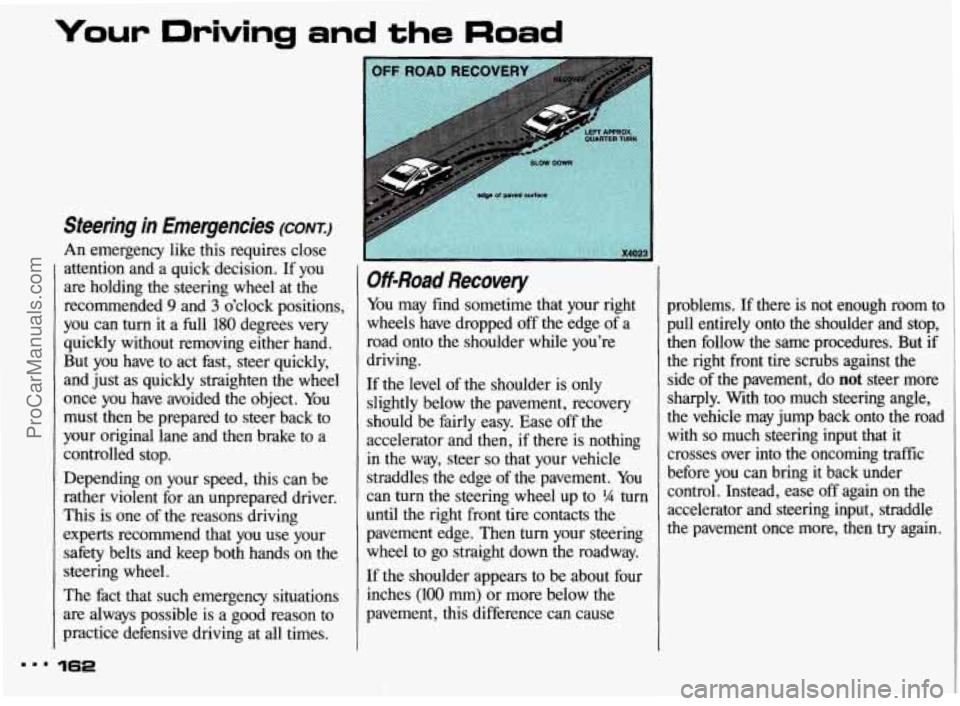
‘Your Driving and the Road
Steering in Emergencies (CONI)
An emergency like this requires close
attention and a quick decision.
If you
are holding the steering wheel at the
recommended
9 and 3 o’clock positions,
you can turn it a full
180 degrees very
quickly without removing either hand.
But you have
to act fast, steer quickly,
and just as quickly straighten the wheel
once you have avoided the object. You
must then be prepared to steer back to
your original lane and then brake
to a
controlled stop.
Depending
on your speed, this can be
rather violent for an unprepared driver.
This is one of the reasons driving
experts recommend that you use
your
safety belts and keep both hands on the
steering wheel.
The fact that such emergency situations
are always possible is a good reason to
practice defensive driving at all times.
162
Off-Road Recovery
You may find sometime that your right
wheels have dropped off the edge
of a
road onto the shoulder while you’re
driving.
If the level of the shoulder is
only
slightly below the pavement, recovery
should be fairly easy. Ease off the
accelerator and then, if there is nothing
in
the way, steer so that your vehicle
straddles the edge of the pavement. You
can turn the steering wheel up to
5/4 turn
until the right front tire contacts the
pavement edge. Then
turn your steering
wheel to go straight down the roadway.
If the shoulder appears
to be about four
inches
(100 mm) or more below the
pavement, this difference can cause problems.
If there is
not enough room to
pull entirely onto the shoulder and stop, then follow the same procedures. But if
the right front tire scrubs against the side of the pavement, do
not steer more
sharply. With too much steering angle,
the vehicle may jump back onto the road
with
so much steering input that it
crosses over into the oncoming traffic
before you can bring it back under
control. Instead, ease off again on the
accelerator and steering input, straddle
the pavement once more, then
try again.
ProCarManuals.com
Page 164 of 322
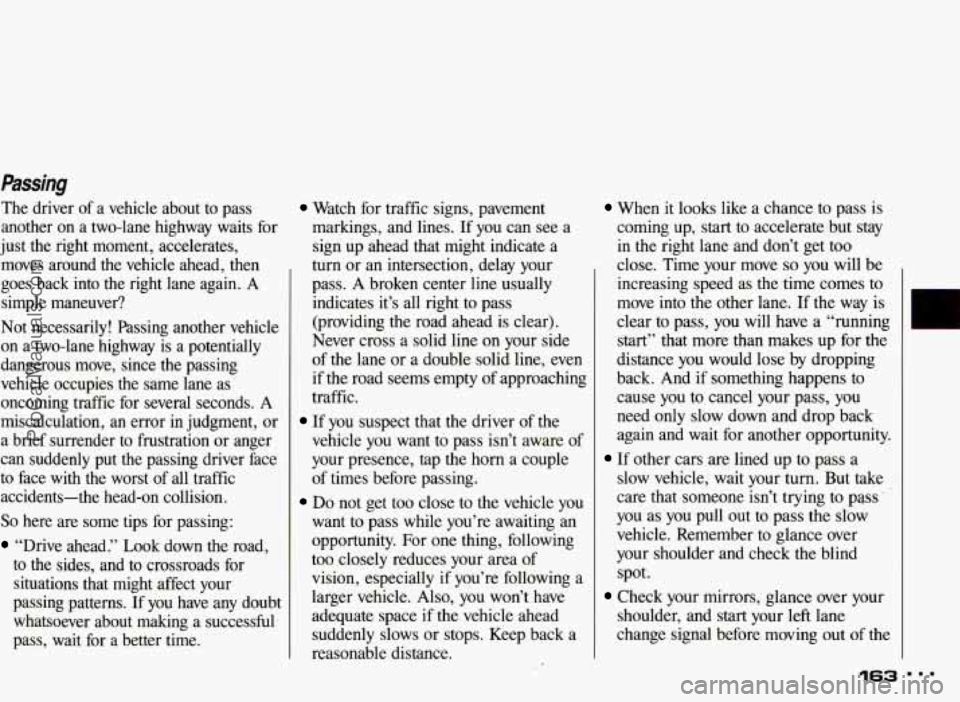
Passing
The driver of a vehicle about to pass
another on a two-lane highway waits for
just the right moment, accelerates,
moves around
the vehicle ahead, then
goes back into the right lane again.
A
simple maneuver?
Not necessarily! Passing another vehicle
on a two-lane highway is a potentially
dangerous move, since the passing
vehicle occupies the same lane as
oncoming traffic for several seconds.
A
miscalculation, an error in judgment, or
a brief surrender to frustration or anger
can suddenly put the passing driver face
to face with the worst of all traffic
accidents-the head-on collision.
So here are some tips for passing:
“Drive ahead.” Look down the road,
to the sides, and to crossroads for
situations that might affect your
passing patterns. If you have any doubt
whatsoever about making a successful.
pass, wait for a better time.
Watch for traffic signs, pavement
markings, and lines.
If you can see a
sign up ahead that might indicate a
turn or an intersection, delay your
pass. A broken center line usually
indicates it’s all right to pass
(providing the road ahead is clear).
Never cross a solid line
on your side
of the lane or a double solid line, even
if the road seems empty of approaching
traffic.
vehicle you want
to pass isn’t aware of
your presence, tap the horn a couple
of times before passing.
Do not get too close to the vehicle you
want to pass while you’re awaiting an
opportunity. For one thing, following
too closely reduces your area of
vision, especially if you’re following
a
larger vehicle. Also, you won’t have
adequate space
if the vehicle ahead
suddenly slows or stops. Keep back a
reasonable distance.
If you suspect that the driver of the
When it looks like a chance to pass is
coming up, start to accelerate but stay
in the right lane and don’t get too
close. Time your move
so you will be
increasing speed as the time comes to
move into the other lane. If the way is
clear to pass, you will have a “running
start’’ that more than makes up for the
distance you would lose by dropping
back. And if something happens to
cause you to cancel your pass,
you
need only slow down and drop back
again and wait for another opportunity.
slow vehicle, wait your turn. But take
care that someone isn’t trying to pqss
you as
you pull out to pass the slow
vehicle. Remember to glance over
your shoulder and check the blind
spot.
Check your mirrors, glance over your
shoulder, and start your left lane
change signal before moving out
of the
If other cars are lined up to pass a
L
163
ProCarManuals.com
Page 165 of 322
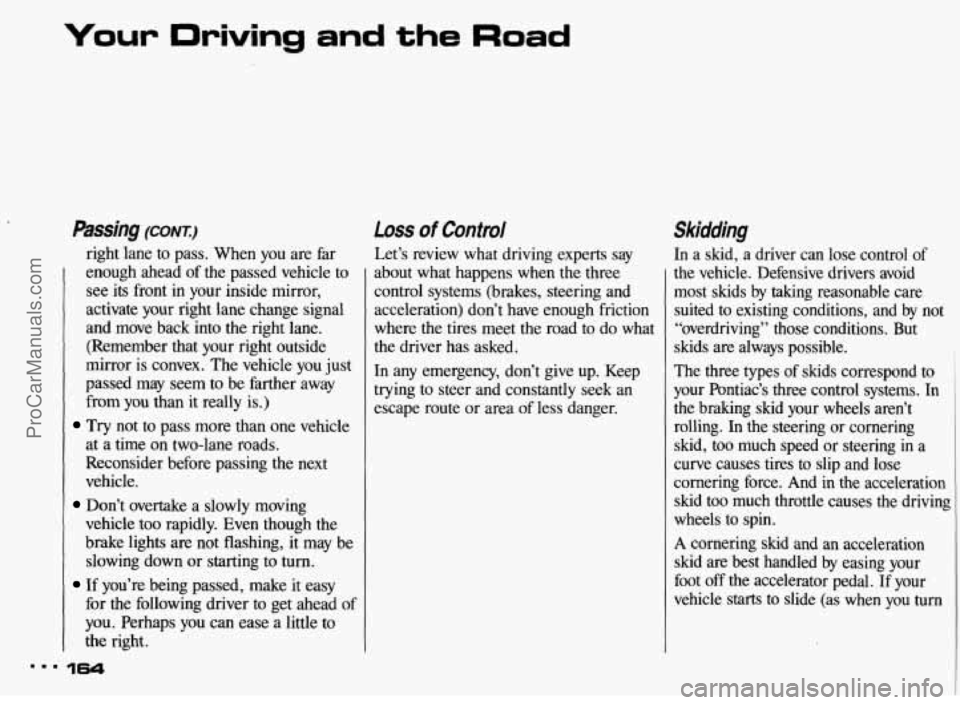
Your Driving and the Road
Passing (CONX:)
right lane to pass. When you are far
enough ahead of the passed vehicle to
see its front in your inside mirror,
activate your right lane change signal
and move back into the right lane.
(Remember that your right outside
mirror is convex. The vehicle you just
passed may seem to be farther away
from you than it really is.)
Try not to pass more than one vehicle
at a time on two-lane roads.
Reconsider before passing the next
vehicle.
vehicle too rapidly. Even though the
brake lights are not flashing,
it may be
slowing down or starting to
turn.
If you’re being passed, make it easy
for the following driver to get ahead
of
you. Perhaps you can ease a little to
the right.
Don’t overtake a slowly moving
Loss of Control
Let’s review what driving experts say
about what happens when the three
control systems (brakes, steering and
acceleration) don’t have enough friction
where the tires meet the road to do what
the driver has asked.
In any emergency, don’t give up. Keep
trying to steer and constantly seek
an
escape route or area of less danger.
Skidding
In a skid, a driver can lose control of
the vehicle. Defensive drivers avoid
most skids by taking reasonable care
suited to existing conditions, and by not
“overdriving” those conditions. But
skids are always possible.
The three types of skids correspond to
your Pontiac’s three control systems. In
the braking skid your wheels aren’t rolling. In the steering or cornering
skid, too much speed or steering in a
curve causes tires to slip and lose
cornering force. And in the acceleration
skid too much throttle causes the driving
wheels
to spin.
A cornering skid and an acceleration
skid are best handled by easing your
foot
off the accelerator pedal. If your
vehicle starts to slide (as when
you turn
ProCarManuals.com
Page 166 of 322
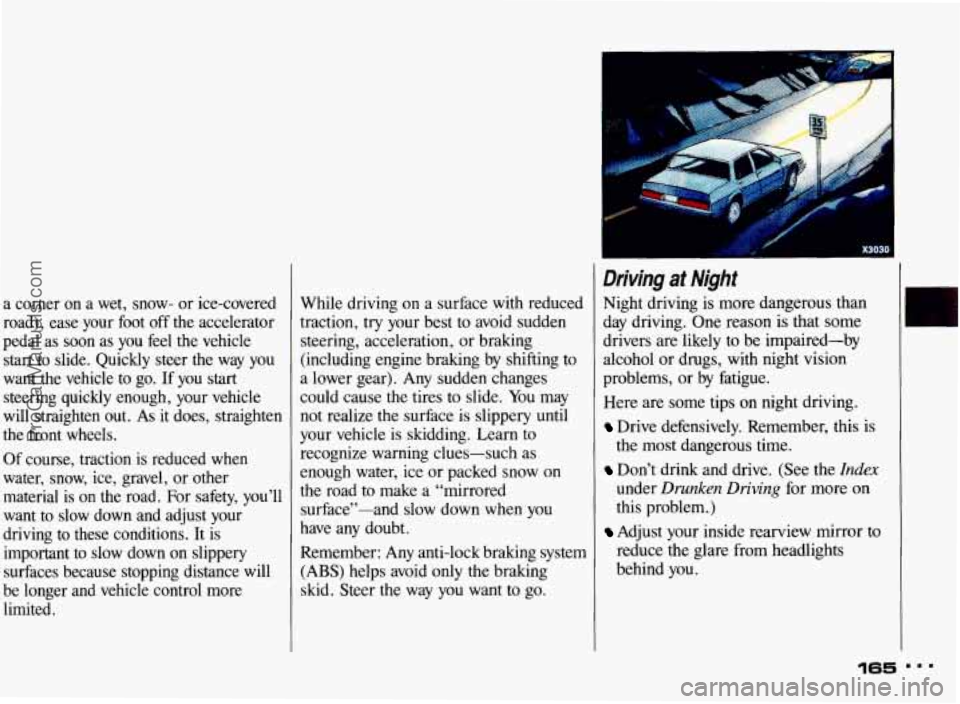
a corner on a wet, snow- or ice-covered
road), ease your foot off the accelerator
pedal as soon as you feel the vehicle
start to slide. Quickly steer the way you
want the vehicle to go. If you start
steering quickly enough, your vehicle
will straighten out. As it does, straighten
the front wheels.
Of course, traction is reduced when
water, snow, ice, gravel, or other
material is
on the road. For safety, you’ll
want to slow down and adjust your
driving to these conditions. It is
important to slow down on slippery
surfaces because stopping distance will
be longer and vehicle control more
limited. While
driving on a surface with reduced
traction, try your best
to avoid sudden
steering, acceleration, or braking
(including engine braking by shifting
to
a lower gear). Any sudden changes
could cause the tires to slide. You may
not realize the surface
is slippery until
your vehicle is skidding. Learn to
recognize warning clues-such as
enough water, ice
or packed snow on
the road to make a “mirrored
surface”-and slow down when
you
have any doubt.
Remember: Any anti-lock braking system
(ABS) helps avoid only the braking
slud. Steer the way you want to go.
Driving at Night
Night driving is more dangerous than
day driving. One reason is that some
drivers are likely to be impaired-by
alcohol or drugs, with night vision
problems, or by fatigue.
Here are some tips on night driving.
Drive defensively. Remember, this is
the most dangerous
time.
Don’t drink and drive. (See the Index
under Drunken Driving for more on
this problem.)
Adjust your inside rearview mirror to
reduce the glare from headlights
behind you.
165
ProCarManuals.com
Page 167 of 322
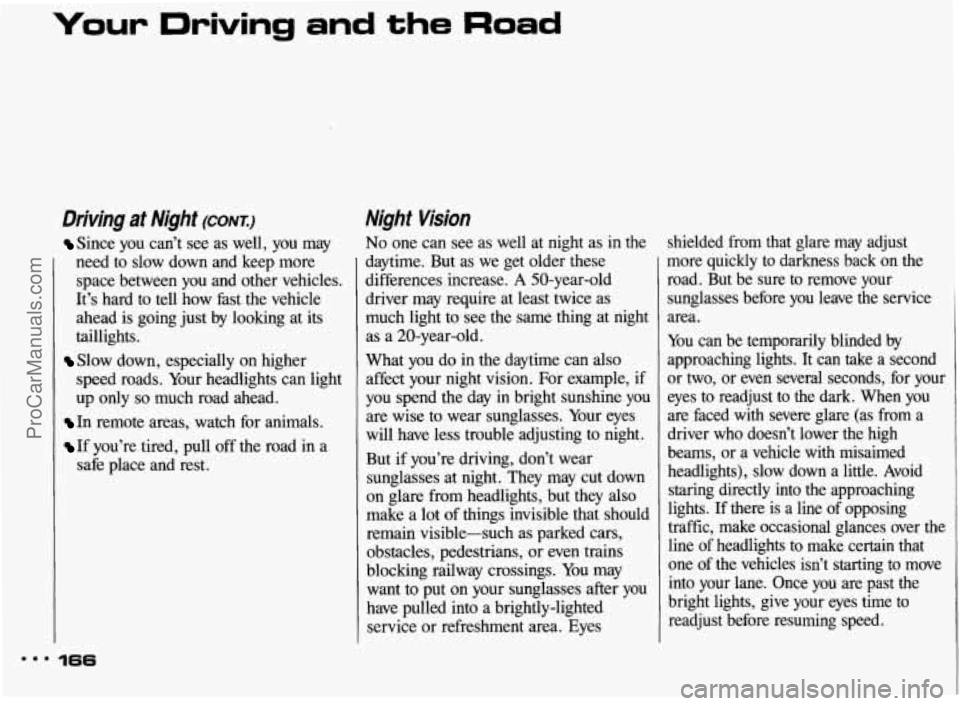
Your Driving and the Road
Driving at Night (CONT.:)
Since you can’t see as well, you may
need to slow down and keep more
space between you and other vehicles.
It’s hard
to tell how fast the vehicle
ahead is going just by looking at its
taillights.
Slow down, especially on higher
speed roads, Your headlights can light
up only
so much road ahead.
In remote areas, watch for animals.
If you’re tired, pull off the road in a
safe place and rest.
Night Hsion
No one can see as well at night as in the
daytime. But as we get older these
differences increase.
A 50-year-old
driver may require at least twice as
much light
to see the same thing at night
as a 20-year-old.
What you do in the daytime can also
affect your night vision. For example, if
you spend the day in bright sunshine you
are wise to wear sunglasses. Your eyes
will have less trouble adjusting to night.
But if you’re driving, don’t wear
sunglasses at night. They may cut down
on glare from headlights, but they also
make a lot of things invisible that should
remain visible-such as parked cars,
obstacles, pedestrians, or even trains
blocking railway crossings.
You may
want to put
on your sunglasses after you
have pulled into a brightly-lighted
service or refreshment area. Eyes shielded from that glare
may adjust
more quickly to darkness back
on the
road. But be sure to remove your
sunglasses before you leave the service
area.
You can be temporarily blinded by
approaching lights. It can take a second or two, or even several seconds, for your
eyes to readjust to the dark. When you
are faced with severe glare (as from a
driver who doesn’t lower the high
beams, or a vehicle with misaimed
headlights), slow down a little. Avoid
staring directly into the approaching
lights.
If there is a line of opposing
traffic, make occasional glances over the line
of headlights to make certain that
one of the vehicles isn’t starting to move
into your lane. Once you are past the
bright lights, give your eyes time to
readjust before resuming speed.
mmm 166
ProCarManuals.com
Page 168 of 322
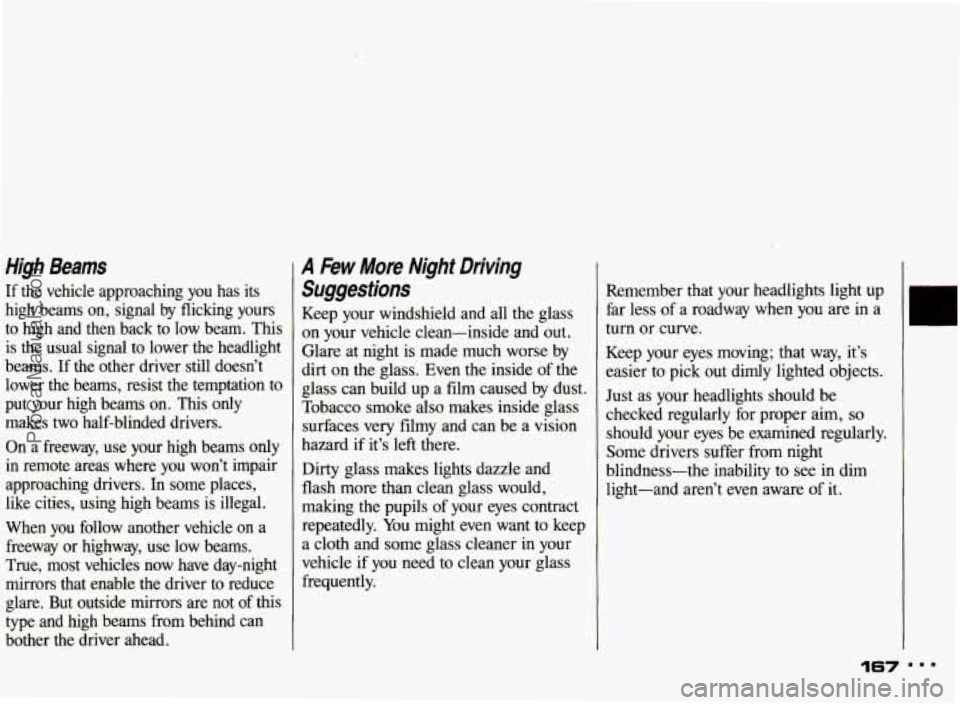
High Beams
If the vehicle approaching you has its
high beams
on, signal by flicking yours
to high and then back to low beam. This
is the usual signal to lower the headlight
beams. If the other driver still doesn’t
lower the beams, resist the temptation to
put your high beams
on. This only
makes two half-blinded drivers.
On a freeway, use your high beams only
in remote areas where you won’t impair
approaching drivers.
In some places,
like cities, using high beams is illegal.
When
you follow another vehicle on a
freeway or highway, use low beams.
True, most vehicles now have day-night
mirrors that enable the driver to reduce
glare. But outside mirrors are not of this
type and high beams from behind can
bother the driver ahead.
A Few More Night Driving
Suggestions
Keep your windshield and all the glass
on your vehicle clean-inside and out.
Glare at night is made much worse by
dirt on the glass. Even the inside
of the
glass can build up a film caused by dust.
Tobacco smoke also makes inside glass
surfaces very filmy and can be a vision
hazard if it’s
left there.
Dirty glass makes lights dazzle and
flash more than clean glass would,
making the pupils of your eyes contract
repeatedly. You might even want to keep
a cloth and some glass cleaner in your
vehicle if you need to clean your glass
frequently. Remember that your headlights light up
far less of a roadway when you are in a
turn or curve.
Keep your eyes moving; that way, it’s
easier to pick out dimly lighted objects.
Just as your headlights should be
checked regularly for proper aim,
so
should your eyes be examined regularly.
Some drivers suffer from night
blindness-the inability to see in dim
light-and aren’t even aware
of it.
167
ProCarManuals.com
Page 169 of 322
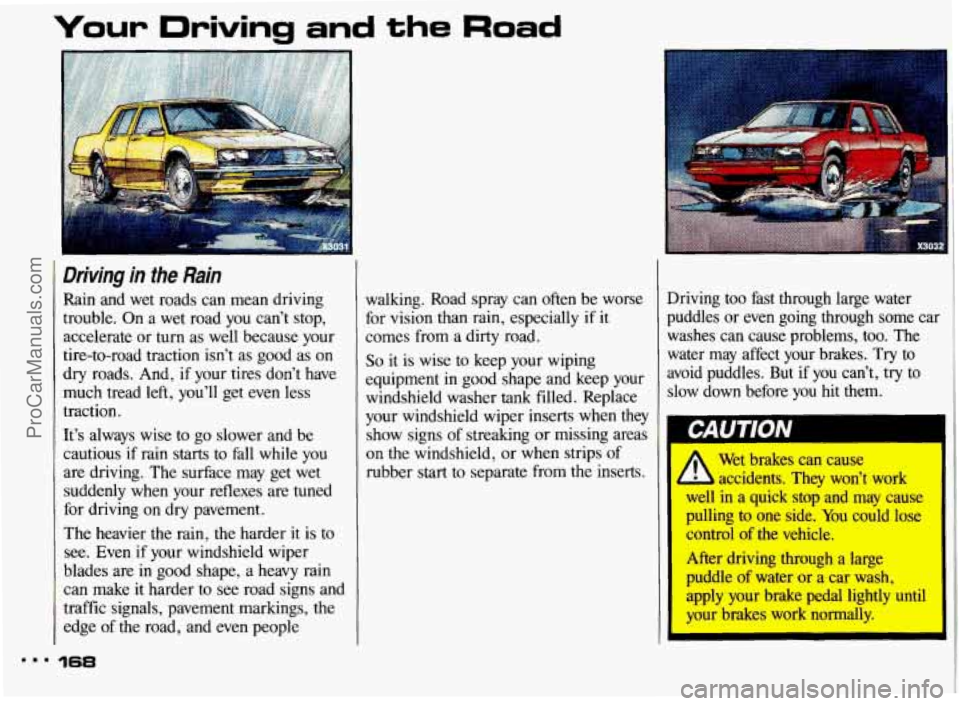
Your Driving and the Road
I
Driving in the Rain
Rain and wet roads can mean driving
trouble. On a wet road you can’t stop,
accelerate or turn as well because your
tire-to-road traction isn’t as good as on
dry roads. And,
if your tires don’t have
much tread
left, you’ll get even less
traction.
It’s always wise to go slower and be
cautious
if rain starts to fall while you
are driving. The surface may get wet
suddenly when your reflexes are tuned
for driving on dry pavement.
The heavier the rain, the harder
it is to
see. Even
if your windshield wiper
blades are
in good shape, a heavy rain
can make
it harder to see road signs and
traffic signals, pavement markings, the
edge of the road, and even people
168
walking. Road spray can often be worse
for vision than rain, especially
if it
comes from a dirty road.
So it is wise to keep your wiping
equipment
in good shape and keep your
windshield washer
tank filled. Replace
your windshield wiper inserts when they
show signs of streaking or missing areas
on the windshield, or when strips of
rubber start
to separate from the inserts. Driving too fast through large water
puddles
or even going through some car
washes can cause problems, too. The
water may affect your brakes. Try to
avoid puddles.
But if you can’t, try to
slow down before you hit them.
I
u I I(
Wet brakes can cause
l accidents. They won’t work
w in a quick stop and may cause
pulling to one side. You could lose
control
of the vehicle.
After driving through a large
puddle
of water or a car wash,
apply your brake pedal lightly
until
your brakes work normally.
ProCarManuals.com
Page 170 of 322
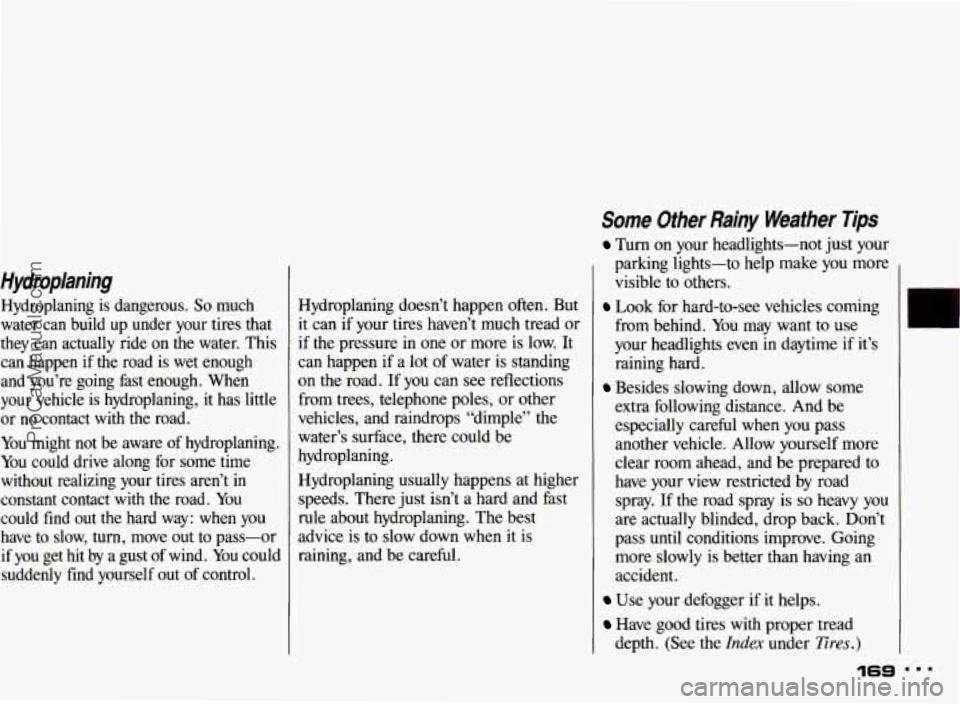
Some Other Rainy Weather Tips
Turn on your headlights-not just your
parking lights-to help make you more
visible to others.
Look for hard-to-see vehicles coming
from behind. You may want to use
your headlights even in daytime if it’s
raining hard.
Besides slowing down, allow some
extra following distance. And be
especially careful when you pass
another vehicle. Allow yourself more
clear room ahead, and be prepared to
have your view restricted by road
spray.
If the road spray is so heavy you
are actually blinded, drop back. Don’t
pass until conditions improve. Going
more slowly is better than having an
accident.
Use your defogger if it helps.
Have good tires with proper tread
depth. (See the
Index under Tires.)
Hydroplaning
Hydroplaning is dangerous. So much
water can build up under your tires that
they can actually ride on the water. This
can happen if the road is wet enough
and you’re going fast enough. When
your vehicle is hydroplaning, it has little
or no contact with the road.
You might not be aware
of hydroplaning.
You could drive along for some time
without realizing your tires aren’t in
constant contact with the road. You
could find out the hard way:
when you
have to slow, turn, move out to pass-or
if you get hit by a gust
of wind. You could
suddenly find yourself out of control. Hydroplaning doesn’t happen
often. But
it can if your tires haven’t much tread
or
if the pressure in one or more is low. It
can happen if a lot
of water is standing
on the road.
If you can see reflections
from trees, telephone poles, or other
vehicles, and raindrops “dimple” the
water’s surface, there could be
hydroplaning.
Hydroplaning usually happens at higher
speeds. There just isn’t a hard and fast
rule about hydroplaning. The best
advice is to slow down when it
is
raining, and be careful.
ProCarManuals.com